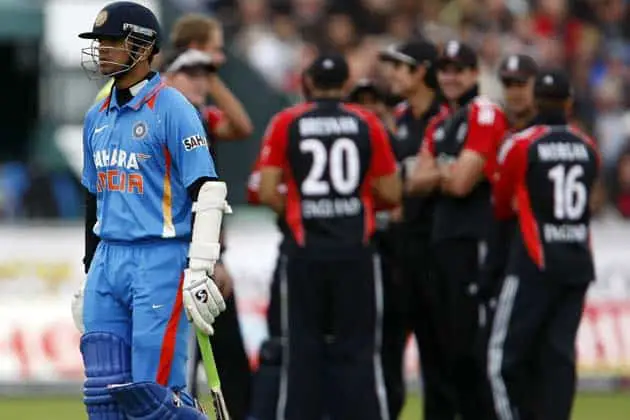Using technology in sports is quite common nowadays. Cricket is no exception to this phenomenon. One such technology that is used in Cricket is Hot Spot. But, what is hot spot technology in cricket and how does it work? We shall uncover the details of this on following article.
But first, what is the Hot Spot technology in Cricket? Hot Spot is part of a ball-tracking technology in Cricket which uses Infra-Red (IR) camera systems to detect the heat signatures caused by ball impact. It is used to determine whether a batsman should be given out or not. It can detect whether the ball struck the player, its equipment or the ground.
But, how exactly does an umpire determine whether a batsman should be given out or not using the Hot Spot technology? Also, why is not not used consistently? Let’s look at it in detail –
What is Hot Spot Technology and How does it work in Cricket?
Hot spot technology was originally founded by a French Scientist Nicholas Bion. The technology was actually developed for the military for tracking tanks and jet fighter planes.
However, the technology has also been adopted in sports – most notably in cricket. It forms an integral part of the Decision Review System (DRS) employed by the ICC. The main goal of this technology in cricket is to determine whether a batsman should be dismissed or given not out.
How does Hot Spot work in Cricket?
In order to determine whether a batsman is out or not, Hot Spot technology helps the umpire by assessing the possible impact of the ball. It can help the umpire to determine whether the ball hit the bat, pad or glove of a batsman, or anything at all. This information can play a pivotal role in determining whether batsman should be out.
You might be wondering – if the umpire can’t figure out if the ball hit the bat or pad of a batsman, how does this technology do it?

The answer is pretty simple. The hot spot technology uses at least 2 infra-red cameras on either end of the straight boundaries. These cameras are mostly installed over the sight screen.
The reason why 2 cameras are used is because at the end of every over, the bowling team as well as the batsmen change ends (meaning they switch the side of the pitch they were batting). Thus, if an infra-red camera was installed on just one side of the cricket pitch, it will not be able to give a front-on view during half the overs rendering it useless.
Coming back to the 2 infra-red cameras – these cameras measure the heat generated by a collision of two objects in motion such as ball hitting the bat, or ball hitting the pad or the ground etc.
The two infra-red (IR) cameras push the information received through a computer which generates a series of black and white negative frames. Using a technique called subtraction technique, the exact point of the contact is identified.
In some matches, a 4-camera setup is used to get a side-on view of the batsman. This can be very helpful in determining whether the ball hit the edge of the bat or even the pad when a straight view in not completely conclusive.
This technology is only employed when a decision is referred to the third umpire using a Decision Review System (DRS) which is requested either by the batsman or the bowling team to review the dismissal.
Uses of Hot Spot Technology in Cricket
Technology is primarily for the following three purposes –
- To determine whether a ball hit/missed a batsman’s bat or gloves during a “catch out” appeal.
- To determine whether a ball hit/missed a batsman bat or gloves during an “Leg Before Wicket” appeal.
- To determine whether the ball bounced before the wicket keeper/fielder caught the ball.
How Accurate is the Hot Spot Technology in Cricket?
When the technology was initially introduced in cricket, it seemed to have an approximate accuracy rate of about 85%. With several improvements to the technology over time, the accuracy of hot spot has improved and reached acceptable levels of about 90-95%.
In fact, in a research paper published in the International Journal of Scientific and Engineering Research, the paper indicated that the hot spot technology had a capacity to reach accuracy levels of up to 99.5%.
However, the technology has had its fair share of controversies. There have been occasions when replays proved inconclusive or it contradicted other complementary technologies. Due to this, doubts were cast on the usage of Hot Spot technology in cricket.
Is Hot Spot the same as Ultra Edge?
No, Hot Spot and Ultra Edge (also known as Snickometer) are not the same. In fact, these are competing technologies.
The main use of the Ultra Edge is to help the umpire in determining if the ball touch either the bat or the pad. It is a sound based technology.
However, Ultra Edge (or Snickometer) fails to give a conclusive decision especially when the bat and pad of a batsman are quite close to each other at the time of impact of the ball. Umpires are often unable to determine whether the sound produced is from the ball hitting the bat or the pad.
Moreover, research has shown that Ultra Edge technology also often captures the sound produced by the movement of the bat (known as “phantom snick”) even when the bat has not hit the ball.
Hot Spot has advantages over its competing technology Ultra Edge especially when it comes to the above two situations. This is because Hot Spot identifies the exact spot of contact rather than informing whether there was a contact or not.
How much does it Cost to use the Hot Spot Technology?
The cost of the Hot Spot technology is minimum $6,000 per day of a cricket match for a two camera setup. The cost can go up to $10,000 per day of a cricket match for a four camera setup.
Part of the reason for limited usage of this technology is the high cost involved in operating it for a match day usage.
When was Hot Spot first used in a Cricket Match?
As mentioned above, the technology was initially developed for military purposes. However, the hot spot technology was first adapted for cricket broadcast by BBG Sports, the Australian company responsible for the Snickometer, in conjunction with Sky Sports.
The first use of the technology was seen during the first test match of the Ashes Series 2006-07 between England and Australia. The match was played at the Gabba in Brisbane, Australia on 23rd November 2006.
ICC later announced that the images from the technology would be used in the 2nd and 3rd Test Match to be held in South Africa in March 2009. The system was made available to the third umpire upon a player referral. This technology was used during these matches for trial purposes which later became a foundation of its regular use in international matches.
So, does it Work? Why is Hot Spot NOT used often in Cricket?
Despite the advantages over its competitors such as Ultra Edge in helping the umpires determine whether a batsman should be given out, the use of Hot Spot has been fairly limited.
This has been the case specifically after the 2013 Ashes series where the Hot Spot technology failed to identify the ball hitting the bat on numerous occasions.
A research conducted later successfully determined that the use of tape on the bat for protective coating (which is quite common practice among cricket players) would strangely, but definitively, diminish hot spot marks on the bat causing the erroneous decisions.
This, coupled with the expensive cost of the technology has been the major hindrance for the lack of consistent use of this technology in the game of Cricket.
Some Controversial Decisions due to Hot Spot Technology
Hot Spot technology has had its fair share of controversies. Let’s have a look at a couple of instances where the Hot Spot technology failed to prove conclusive or opposed a complementary technology system –
Joe Root Incident
Joe Root attempted to play a widish ball. He missed hitting it but the umpire gave him out. Joe Root, very confident of missing the ball, immediately went for a DRS. However, on the replay, Hot Spot suggested an edge while UltraEdge detected once the ball passed the bat.
Since the decision was inconclusive and the original decision was out, Joe Root was given out!
Rahul Dravid Incident, 2011

In 2011, Rahul Dravid was on the receiving end of the Hot Spot technology not once but twice.
During a match in September 2011 in England, Dravid, while facing Stuart Broad, missed hit a shot and was given “not out” by the on-field umpire. A subsequent appeal was made and the DRS review was taken by the bowler Stuart Broad. In the replay, hot spot was inconclusive, however, Ultra Edge showed a faint edge. Subsequently, Dravid was given out.
In an earlier incident in the third test against England, Dravid was given out “caught-behind” even though his bat had hit the shoelace and not the ball.
Such technology failures made the Indian media rename DRS as “Dravid Removal System”.

